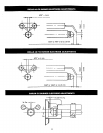
MAINTENANCE
ANUALLY: To assure trouble-free operation, it is recommended that the flue passages, combustion
chamber area (target wall, fire door insulation, durablanket), burner adjustment, operation of the controls,
and boiler seals (fire door gasket or silicone seal, cast iron sectional seals, flue collector) be checked once
each year by a competent Service Technician. Before the start of each heating season (or whenever the
system has been shut down for extended periods of time) recheck the whole system for water, oil, and vent
piping leaks. Replace or patch any leaks or seals that are faulty.
VENT PIPE: Visually inspect the entire venting system once a month for any signs of leakage,
deterioration, or soot build up. If the vent pipe shows any signs of leaking or deterioration, replace it
immediately. If it shows any signs of soot build up, clean the vent pipe and have the burner settings and
combustion checked by a competent professional.
RELIEF VALVE: This valve should open automatically when the system pressure exceeds the pressure
rating (usually 30 psi) of the relief valve. Should the valve ever fail to open under this condition, shut down
the system. Drain the system until system pressure is reduced below the relief valve pressure rating. Then
contact a competent Service Technician to replace the valve and inspect the heating system and determine
the cause, as this problem may indicate an equipment malfunction. The relief valve should be tested monthly
during the heating season. Prior to testing, make certain a discharge pipe is properly connected to the valve
outlet and arranged so as to contain and safely dispose of boiler discharge. Hold the trip lever fully open for
at least five seconds in order to flush free any sediment that may lodge on the valve seat. Then permit the
valve to snap shut. Refer to the valve manufacturer's instructions packaged with the valve for more details.
CONVENTIONAL EXPANSION TANK: As noted in the EQUIPMENT AND OPTIONAL
ACCESSORIES section, this tank may become water logged or may receive an excess of air. Frequent
automatic opening of the relief valve indicates water logging. A high boiler temperature accompanied by
unusually low radiation unit temperature (and "knocking" noises) indicates excess air in the tank. To correct
either condition, close the valve between the boiler and the tank. Drain the tank until empty. Check all the
tank plugs and fittings, tighten as necessary. Open the valve between the boiler and tank. Water will rise to
the normal height in the tank if the system has an automatic _l valve, otherwise manually refill the system.
DIAPHRAGM EXPANSION TANK: As noted in the EQUIPMENT AND OPTIONAL ACCESSORIES
section, this tank may become water logged. Frequent automatic opening of the relief valve indicates water
logging. A high boiler temperature accompanied by unusually low radiation unit temperature (and
"knocking" noises) indicates excess air in the tank. To correct this condition, replace the diaphragm
expansion tank.
WATER SYSTEM: If the system is to remain out of service during freezing weather, always drain it
completely (water left in to freeze will crack the pipes and/or boiler).
TANKLESS COIL (OR COVER PLATE) GASKET: This gasket should be checked at least twice a year
for leakage and replaced if necessary. If the gasket is replaced, make sure that when the coil plate (or cover
plate) is reattached that the ten nuts are torqued in an alternating pattern to ensure equal force is applied to
the entire gasket creating a good seal. The nuts should be torqued such that the gasket does not squeeze out
from behind the plate.
OIL BURNER: Oil burner maintenance is listed in this manual under OPERATING THE BOILER.
I
Never burn garbage or paper in the unit, and I
never leave combustible material around it.
I
25


















